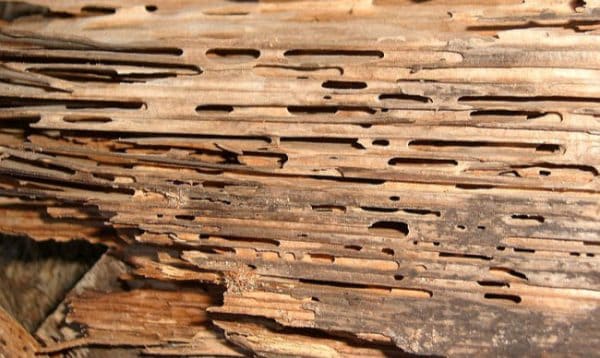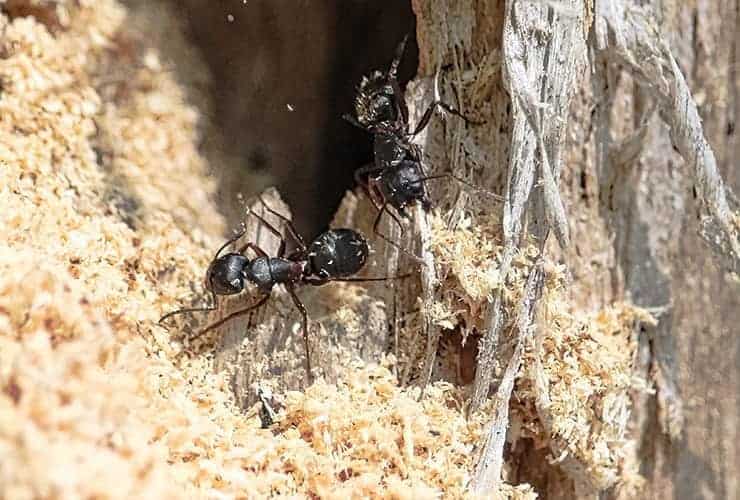How to Get Rid of Carpenter Ants
If you’re noticing damage to any wooden structures in or around your home, your first reaction might be to assume it’s a termite infestation.
But if the damage includes a sawdust-like substance, then you aren’t dealing with termites. You’re dealing with carpenter ants.
While they don’t ingest wood like termites do, carpenter ants can still cause plenty of problems if they aren’t dealt with. They can burrow through your walls and furniture, creating tunnels that might affect the stability of the house.
What Are Carpenter Ants?
Carpenter ants are the most common subspecies of ant in the world. They can be found on every continent inhabited by humans: in North America, their range extends from the East Coast all the way to the Rocky Mountains.

They are immediately recognizable for their black coloration and yellow-colored abdomens. Their abdomen gets its color from tiny hairs.
Carpenter ants typically make nests inside damp, dead wood, but they will gladly inhabit any wooden structures. They lack the ability to digest wood that termites have, so they leave behind a sawdust-like substance called frass.
(The frass is used by the ants as a trail, leading them to different parts of the nest. It can be exploited by people looking to exterminate an ant colony.)
What Attracts Carpenter Ants?
Carpenter ants, like all animals, are driven by instinct to find a suitable territory. They need to make their nest someplace where they have a secure shelter and a regular supply of food.
They’ll eat just about anything–fruits, meat, and stray crumbs of human foods. They might be introduced into a home by hiding in unused firewood, or by finding a more humid climate indoors than outdoors.
Once the ants have established their colony, they won’t leave on their own. They are incredibly resilient and won’t leave because of changes in their environment.
(In contrast to other pests, like spiders or rats, who will eventually leave on their own if deprived of food or shelter.)
Signs of Carpenter Ants in Your Home
It doesn’t take long for carpenter ant colonies to grow in large numbers. The colony’s queen can lay up to 20 eggs a day, and each ant fully matures in just 12 weeks. Hundreds, if not thousands of ants can build a massive colony in the walls of your home in just under a year.
If a carpenter ant colony has taken up residence in your home, you’ll probably be made aware of their presence because of rustling noises inside your walls or furniture. This rustling comes from the ants burrowing deeper into the wood, and has been described as similar to cellophane crinkling.
(People who have dealt with carpenter ants also note that the rustling is more noticeable at night.)

Traces of frass or rotting wood are another sign of carpenter ants. Water or mold can seep into the cracks left by the ants as they burrow, leading to wood rot.
If you find a carpenter ant and it has wings, then you’re dealing with an established colony. Carpenter ants don’t develop wings for several years after they’re born, so if you’re finding winged insects, then the infestation has been happening right under your nose for a long time.
Preventing a Carpenter Ant Infestation
If you already have a carpenter ant infestation, then the only solution available to you is calling an exterminator. However, there are some steps you can take to prevent an infestation before it happens.
Trimming any trees in your yard and keeping firewood away from your house are 2 effective methods of keeping ants out. Since carpenter ants thrive in trees and woodpiles, they can use these as a starting point for worming their way indoors.
(They have been known to jump down from trees onto the roofs of houses, and then make their way inside from there.)
It’s also a good idea to seal up any cracks or crevices the ants could use to infiltrate your home. Setting up traps around the perimeter of your home can also help.
Click here to learn more about select brands of traps recommended for ant infestations.
If the ants haven’t made their nest inside your home yet, but you manage to locate their colony outside, you can destroy it with store-brand insecticides.
How Do Exterminators Remove Carpenter Ants?
If carpenter ants have entrenched themselves in your home, then the only means of removing them is by calling a pest control service. The exterminator will locate the nest by following any frass trails left behind by the ants.
(Structural damage is another clue exterminators will use to locate a colony. Even after a successful treatment, you may need to hire someone to repair the damage.)
Once a colony has been located, the exterminator will use boric acid or toxic baits to kill the ants. Depending on the size of the colony, this process could require multiple treatments.
How to Get Rid of Carpenter Ants if You Have Pets
If you’re a pet owner, then you would probably be worried about how a pest infestation would affect the well-being of your furry companion. Fortunately, carpenter ants pose no threat to pets.
Carpenter ants don’t drink blood, so they won’t bite your pet the way fleas or ticks would. In fact, mammals aren’t even considered a food source for these ants–rather, carpenter ants rely on dead insects to supplement their diet.
They have no venom, nor do they carry any transmittable diseases. If a carpenter ant does bite your pet, the damage dealt will be minimal.
During a professional treatment, though, it’s best to keep your pet away from the chemicals used to kill the ants. While most insecticides don’t pose an immediate danger to pets, try to keep them out of reach so your pet doesn’t accidentally ingest them.










